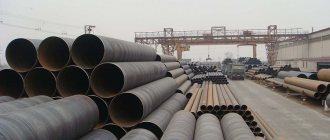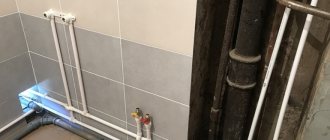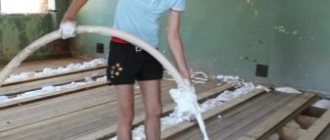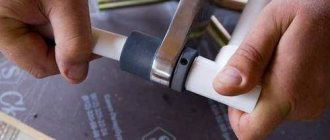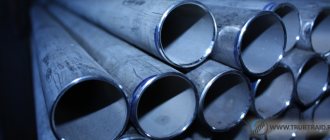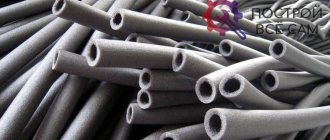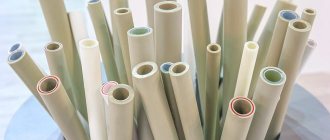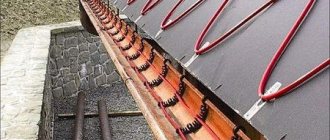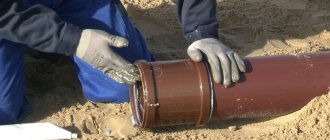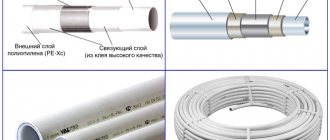How to make the perfect galvanized pipe with your own hands: step-by-step instructions
Good day, dear guest!
The first sheet with galvanic coating came off the assembly line of one of the British factories back in 1867. True, at that time the metal was covered exclusively with gold and silver. But before the First World War, the production of parts with a protective layer of zinc began to be produced, and since then they have been incredibly popular.
This is not surprising - zinc extends the life of iron by 20-30 times. Products made of galvanized steel are durable, do not rust, and behave in everyday life no worse than stainless steel, although they are much cheaper.
In today’s article, I propose to pay more attention to this modest material and tell you how to make a galvanized pipe with your own hands.
Advantages and disadvantages of such a pipe
Galvanization is primarily steel, a material that has many undeniable advantages.
- Strength;
- Ability to withstand high temperatures;
- Excellent thermal conductivity;
- Low cost compared to other materials.
But without a protective coating, ferrous metal is susceptible to corrosion, quickly rusts and becomes unusable. Galvanizing successfully solved this problem. And, despite the fact that galvanized and steel pipes are the same in shape, the galvanized product has a number of advantages.
Additional advantages of galvanized products:
- Corrosion resistance, the ability to withstand negative environmental influences;
- Increased service life;
- Increased strength;
- Wide operating temperature range;
- High resistance to mechanical stress;
- Galvanized pipe can withstand high internal and external pressure;
- Simplicity and ease of installation;
- High resistance to fire;
- Zinc kills all pathogenic microorganisms;
- Galvanization is practically not inferior in quality to low-alloy stainless steel, but costs an order of magnitude less.
But, like any engineering solution, a galvanized iron pipeline is not ideal.
- Not very attractive design;
- Expensive compared to conventional steel;
- Zinc complicates the welding process;
- Unlike plastic, if there are protrusions on the walls, it is almost impossible to ensure a smooth transition into structures made of galvanized pipes.
Sheet metal.
Sheet metal is a material that is made in the form of a thin sheet. This product is delivered in rolls. Depending on the application, sheet metal can be produced in a specific edge. It has found wide application in various fields of industry, from construction to delicate products.
Each type of sheet metal has a special manufacturing principle. As a rule, the rolling method is used for its production, using cold or hot temperatures. The size of the sheet metal can range from 04 to 4 millimeters. To manufacture such a metal product, low-level alloy steel is used. This type of steel has a high level of strength and is light in weight.
One of the most popular types is a steel product, which has stainless and galvanized characteristics.
Sheet metal is a product that allows you to solve problems associated with complex design problems. It allows the production of bolted and welded structures, chemical equipment, car bodies and ship hulls. The main advantages include a high level of corrosion resistance and a long service life. The companies employ specialists who will give the necessary recommendations on choice, depending on the preferences and wishes of the client.
Basically, sheet metal is used as a basis for the preparation of any parts. The main areas of application of sheet metal include: construction, shipbuilding and automotive industry, production of tableware, furniture, decorative elements and landscape design, electrical energy.
Sheet metal is divided into several main types:
1. Rolled metal, stainless steel.
2. Corrugated rolled metal.
3. Rolled metal produced by cold rolling.
4. Rolled metal produced by hot rolling.
5. Corrugated sheets and galvanized metal products.
Each type has its own classification and characteristics. The class of steel used divides the metal sheet into:
1. Steel, which has a standard level of quality.
2. Low alloy steel sheet.
3. Structural steel sheet.
The cost of the product is affected by the material from which it will be made. Depending on the client's preference, delivery is carried out in rolls or sheets.
Our company offers the widest selection of rolled metal. Environmental safety, resource and energy saving You can buy any metal from us today Safety, resource and energy saving You can buy any metal from us today.
Cargo delivery offers the widest selection of rolled metal products. Environmental safety, resource and energy saving You can buy any metal from us. Ecologist of safety, resource and energy saving You can buy any metal from us.
Types of steel chimneys
Steel chimneys vary in pipe material and type of construction. Steel is used in several varieties:
- Black without coating. This material is the cheapest, but at the same time the least durable. Such steel is susceptible to corrosion and quickly becomes unusable.
- Low alloy steel. Chromium, zinc, nickel, and molybdenum are used as impurities for this material. This alloy is less susceptible to corrosion than ordinary black steel.
- Stainless steel. The best possible option. Pipes made of this material have all the advantages of steel chimneys.
- Corrugated steel. It is the least reliable option, since due to the corrugated wall, soot quickly settles on the pipe. Such a chimney will have to be cleaned frequently. Corrugated material is used for lining.
This is interesting! Restoration work on old stove chimneys is called lining. In this case, a new, usually steel, pipe is placed inside the existing brick frame. Lining can significantly improve the aerodynamics of an old chimney.
Based on the type of structure, the following types of chimneys are distinguished:
- Single-walled. Such pipes have one wall, with a diameter of 0.6 to 1 mm. They do not have thermal insulation, so it is dangerous to use them for heating appliances in the house. They have found application in bathhouses, where water can be heated using a constantly hot pipe.
- Single-walled for sleeving. Such pipes may be no different from ordinary single-wall pipes; they may be corrugated or have an oval shape. Their distinctive feature is their location inside an old brick chimney.
- Sandwich systems. The most common and reliable of all options. They consist of inner and outer pipes, between the machines there is a layer of insulating material. This design avoids heating the outer surface of the pipe and the formation of condensation.
- Pipe-in-pipe design. This system differs from the previous version by the absence of an insulating layer. Such chimneys are called coaxial. The inner pipe in them is needed to remove combustion products; air moves through it from bottom to top. Along the outer pipe, that is, the layer between two pipes, air flows move in the opposite direction. They are necessary to maintain fuel combustion. This design helps to increase draft in the inner pipe, but it cannot be used in low temperature conditions due to freezing of condensate on the walls.
Pipe production technology
Differences in production technology
The presence or absence of a weld is the main feature that gives an idea of how steel pipes are made. Based on this characteristic, rolled products are divided into two industrial groups:
- seamless products obtained by piercing a round or faceted steel billet with subsequent rolling and rolling of a hollow sleeve;
- welded pipes obtained by plastic deformation of sheet steel followed by welding and processing of spiral or straight seams.
Seamless products are produced on pipe rolling mills operating in conjunction with short-mandrel installations. Seamless methods for manufacturing steel pipes are quite expensive due to the large consumption of material when forming the sleeve. Welded products are much cheaper, but in terms of strength indicators they are inferior to seamless pipes. Therefore, they try to use seamless rolled products only in cases where, according to calculated data, pipes with a seam may not withstand the load.
Production of welded pipe products
The range of welded pipe products is significantly wider. The diameter of this product reaches 2.5 m. The starting material for production is steel strip or sheet metal. The type of material determines how seams are made and welded steel pipes are manufactured.
Methods for producing welds:
- longitudinal welding of cold-deformed sheet stock;
- forging method of connecting joints;
- electric arc method of submerged arc welding;
- electric contact welding in a pipe-electric welding unit.
In accordance with the latest methodology, steel water and gas pipes are manufactured to protect against corrosion phenomena. Since the products are designed to work under hydraulic pressure, careful control of wall thickness and welding quality is carried out.
What are steel pipes made of?
In the manufacture of rolled pipes, ordinary low-alloy and stainless steel alloys are used. The choice of material for the production of steel pipes is carried out in accordance with the requirements specified in GOST:
- grade KP - boiling steel of ordinary quality - is used in the production of pipes operated at temperatures not lower than minus 20ºС;
- PS and SP grades - calm and semi-calm boiling categories - are used in the manufacture of rolled pipes that work well at low temperatures;
- low-alloy alloys are used for the manufacture of rolled pipes that can withstand significant temperature fluctuations;
- Stainless steel alloys are required in the production of pipes intended for transporting aggressive substances.
Since low-alloy types of steel for pipes are characterized by poor weldability, installation of pipelines from them is carried out using shaped parts.
Selection tips and approximate price
As usual, let's start with the price. A finished pipe with a diameter of 100 mm and a length of 3 meters will cost you and me about 500 rubles.
The cost of the material in this case is 150 rubles, the rest is labor costs and the seller’s markup.
What if you plan to organize an entire drainage system? You can see for yourself that you will have to overpay for finished products by 2.5-3 times. Making your own pipes will greatly ease the financial burden.
In addition, factory products have strictly defined dimensions, and sometimes it is difficult to choose the right one for your system. And the thickness of the finished pipe usually does not exceed 1 mm.
You should definitely remember that any factory-made product, unlike a home-made one, undergoes strict quality control control, has a perfectly round surface and a precision weld.
Whether a home master will be able to ensure compliance with all these conditions is far from certain.
Material characteristics
Thin sheet steel coated with zinc in the factory must comply with GOST 14918-80. Main characteristics that you should pay attention to when choosing:
The most common galvanizing thicknesses are from 0.35 to 3mm. The thinner the sheet, the easier it is to process, which is important for making products at home. But don’t forget – less thickness means less strength.
There are 3 classes of material, in accordance with the thickness of the zinc coating layer. Let's summarize the data in a table for convenience.
How to make a pipe from a sheet of metal
Received it on the way out. The task is worth it. How to bend the edge, you can’t grab it at the end. Try using a hammer, mallet, bending, or simply cutting off the part that is not bent (just remove). Then we make a measuring rope. We measure what diameter is needed and make a measuring rope, say 30 cm. We measure. On the other side we make a mark and use a grinder to cut and remove a part. Next piece of pipe. When everything has been cut and removed, we weld the seam and get a 1.5 mm metal pipe without using sheet bending machines.
The next one, the same distance, is cut off and welded again. They will be welded into one long pipe. The end result of a welded finished product. This is one part, as you can see, the second and third, so gain length. In this simple way you can make the pipe you need at home. Thank you for your attention.
What metal bending services do we offer?
We work using the cold method. As a result, the client receives a solid, aesthetically attractive piece without a single seam.
- Sheet and galvanized metals.
- Aluminum and alloys.
- Stainless steel.
- Pipes.
- Chermet.
- Brass.
- Copper.
The profile of our company is metal bending of any complexity in Moscow.
Equipment used
Bending, straightening and straightening of metal is carried out on CNC bending machines, sheet bending machines, and lasers. We help not only large clients, but also take on small orders for designer decorative elements for apartments, country houses and cottages. Our high-precision equipment and experienced operators guarantee fast, high-quality, highly accurate products for your project.
CNC equipment is in demand in manufacturing and fitting:
- boxes;
- brackets;
- ebb and flow for window structures and building profiles with complex structures;
- racks and shelves;
- corners;
- cassettes for facades and cathedral elements;
- channels.
In addition to standard cutting, we provide the material for the manufacture of the necessary structures and are ready to deliver to an enterprise or private home.
Methods used
The methods that our specialists use when punching and bending metal in Moscow completely preserve its design, while significantly increasing its performance.
We use the following types of bending to order:
We are aware of the latest developments in the world of engineering and use advanced methods of steel processing, which allows us to significantly reduce work completion time with consistently high quality. For each type, we will offer processing options to obtain excellent results. Production is as automated as possible and is under the control of experienced master engineers. Work on modern machines with unique software is carried out in any plane, in several directions and along a variable radius.
Price
The exact price of the service depends on the volume and complexity of metal and stainless steel bending.
Calculation of the required cross-section and height of the pipe
To ensure good aerodynamics and adequate traction, it is necessary to comply with the rules prescribed in the relevant SNiP. They regulate the standards for the height and diameter of the pipe section for chimneys.
The height of the pipe depends on the type of roof. Its minimum possible value is 5 m, if measured from the heating device to the head. In addition, it is necessary to calculate the height of the part of the pipe protruding above the roof.
Above a flat roof, the pipe must rise no less than 50 cm. If the roof has a slope, the height of the pipe depends on its location in relation to the ridge of the roof. The location options are as follows:
- Up to 1.5 m from the ridge. In this case, the recommended pipe height is 50 cm higher than the most protruding part of the roof.
- From 1.5 to 3 m from the ridge. With this arrangement, the head should form a straight horizontal line with the roof ridge.
- More than 3m. In this case, the height of the protruding part of the pipe should be such that the angle between the ridge and the head is 10°. In this case, the pipe is located below the ridge.
Assembly Rules
To properly assemble a chimney made of galvanized steel, you must first mark out the layout and laying of the pipe. Using this drawing, you should determine how many pipes are required and cut them into sections of the required length. Assembly is performed as follows:
- First of all, the chimney pipe is connected to the inlet pipe of the heating device using a special adapter. It is important to ensure complete tightness of the connecting seam.
- After the first segment, a tee with a condensate collector and inspection is connected. Each piece of pipe is inserted into the previous one, and the joint is coated with heat-resistant sealant and secured with a steel clamp.
- Where the pipe passes through obstacles in the form of walls or ceilings, holes are cut out and a fire-resistant box made of galvanized steel or asbestos slabs is installed. The space between the walls of the pipe and the box is wrapped with basalt fiber or filled with expanded clay.
Note! The smoke exhaust duct is installed on the roof at a distance of 30-50 cm from the ridge. To ensure the level of draft, the height of the chimney should be 50 cm above the ridge. Incorrect placement on the roof can cause backdraft or wind backlash.
List of tools
Before you begin making sheet metal pipes, you should prepare a list of tools and materials for the job.
- thin roofing galvanized sheet iron 0.5-0.7 mm thick;
- metal strip;
- metal scissors;
- hammer;
- pliers;
- mallet.
It is worth noting that the quality of the material directly affects the final result of the work. That is, to make an ideal tin pipe, the sheet iron must have correctly cut edges, without burrs or torn areas, as well as a smooth surface.
Production of used sheets
The secondary market for metal products is a real source of cost reduction for such resource-intensive industries as construction, agriculture, production of metal structures, etc. For example, a used steel sheet will reduce the cost of an object by 30%. Such savings in modern crisis conditions mean increased competitiveness, and therefore an increase in the profitability of any activity. LLC "EMG-GROUP" has a developed production infrastructure for the supply of used sheet metal products at the first request of the client.
- used hot-rolled sheet
- production of used sheets
- used sheet in Moscow
- used sheets in the Moscow region
- used steel sheet
- used sheet is made from used pipe
| Used sheet | Price, rub/ton |
| 4 | 35000 |
| 5 | 32000 |
| 6 | 32000 |
| 7 | 32000 |
| 8 | 35000 |
| 9 | 35000 |
| 10 | 35000 |
| 11 | 35000 |
| 12 | 35000 |
| 13 | 35000 |
| 14 | 35000 |
| 16 | 35000 |
| 18 | 35000 |
| 20 | 33000 |
| 22 | 33000 |
| 24 | 33000 |
| 30 | 31500 |
| 34 | 35000 |
| 38 | 35000 |
Processing the seam joint
The final stage involves processing the joining seam, that is, crimping it. To do this, the upper part of the L-shaped fold is folded down, wrapping the edge of the other fold. The result should be a kind of sandwich located perpendicular to the pipe. To obtain a joining seam, you need to press the sandwich to the product.
For greater reliability, the joining seam is strengthened using rivets. However, do-it-yourself tin pipes using this joining method do not require additional reinforcement.
Methods for making pipes from tin
Before you make a galvanized pipe with your own hands, you will need to make a drawing of it. The resulting pattern will need to be transferred to a sheet of iron. This can be done either with chalk or a sharp knife.
It is worth considering that when marking the workpiece, its width should be equal to the diameter of the future pipe increased by 1.5 cm, and the length should slightly exceed the height of the straight section of the future pipe.
The finished pipe pattern must be cut with metal scissors and placed on the edge of the workbench.
To create a fold on one side of the workpiece along the entire length, you need to draw a line, stepping back from the edge by 0.5 cm. This line is combined with a corner on the workbench so that using a wooden hammer you can bend the edge of the workpiece down.
Next, the workpiece is turned over and the resulting bend is finally pressed onto the canvas by lightly tapping it with a mallet.
At the next stage, they begin to process the other edge of the pattern. To do this, turn the canvas over and, making a 1 cm indent from the edge, bend the other edge in the same way, but in the opposite direction.
After this, the resulting edge must be bent again so that in cross-section it resembles the letter G.
Now you can start connecting the galvanized pipe with your own hands. If possible, you can use a mandrel (a piece of pipe of the required diameter), however, this is not necessary. So, having inserted the prepared template into the mandrel, they begin to smoothly bend the opposite edges of the pipe towards each other.
The opposite edges are connected so that the smaller part of the lock hooks onto the larger one. After this, the locking connection is pressed and compacted with pliers.
General information
The use or absence of welding is the main difference in the manufacture of in-demand products. Half of all steel pipes produced are welded.
Seams are welded in an oven using electricity and protective gas. Furnace joints are classified as hot-formed.
Shielded inert gas welding technology is used in the production of products made from steel with a high content of alloying elements and stainless steel.
In modern industry, the welding method is at the proper level; the created welded products are of the best quality, not inferior in their characteristics to all-metal ones. Steel metal welded pipes are cheaper than seamless ones and in terms of their characteristics (using innovative technologies) they are not inferior to pipes without seams.
Welded varieties have thin walls, which means they are light and convenient for transportation and installation work. Costs for special equipment for pipe transportation and personnel costs can be reduced.
Another advantage of welded pipes is that they have the same thickness along the entire length, because they are created from a finished steel sheet of one thickness.
Steel pipes are produced by modern manufacturers in round shapes and in the form of ovals, rectangles, and squares. This is dictated by consumers and customer requests. Using a press, a hot-rolled round steel billet takes on the required shapes, is calibrated to the required dimensions and is used by customers depending on the purpose of these profile products.
Pipes are produced in metallurgical plants
Rolling (rolling) of metal
We offer rolling of profile and sheet metal at competitive prices in Krasnodar, we carry out orders of any complexity for both serial parts and piece samples.
Rolling is the uniform deformation of various types of alloys under pressure or the operation of cold forming of metal products (sheet, profile metal, pipes, steel rod) in order to bring the products to a radial or cylindrical shape. Technologically, the process is a gradual drawing of metal in moving rollers on special equipment - rollers. Rolling can be used to process steel alloys, such as stainless steel products, non-ferrous metals, various types of ferrous metals, galvanized sheets and rolled profiles and pipes. For the bending process, workpieces of the following shapes can be used: steel strip, flat sheet, profiled sheet, channel, I-beam, angle, profile and round pipes, fittings, rods, etc.
- Sheet metal rolling
- Pipe rolling
- Advantages
- Rolling of cones
- Prices for rolling in Krasnodar
Our company carries out rolling of various types of metal, including:
- stainless steel;
- Cink Steel;
- non-ferrous alloys;
- ferrous metal products.
Sheet metal rolling
Sheet metal rolling is the uniform deformation of a steel sheet under pressure. Using this method, you can create both blank elements to be welded and joined into a solid structure, as well as finished products. The production of parts is carried out on modern equipment that meets new quality standards and the requirements necessary for work. The process is carried out using forging or bending rollers. A sheet of metal is passed between rollers and, under pressure, gradually takes on the required shape. Bending stainless steel sheets is a rather difficult process, since the main task is to preserve the properties of the sheet's protective coating.
This method is used to produce cylindrical products. Our company carries out rolling of sheets of stainless steel, galvanized steel, aluminum, etc. Processing of rolled sheets in this way is used for the subsequent production of intermediate forms with assembly into finished structures, such as tanks, boilers, containers, pipes of non-standard diameter.
Rolling is carried out on machines with large rounding radii. During the processing of a sheet on a machine, the metal is subjected to uniform deformation with a designated rounding radius, and as a result, the output is a cone or cylinder of sheet metal, depending on the specified rounding angles. Each machine has its own characteristics and limitations on the metal processed, such as thickness, dimensions and bending radius. Depending on the thickness of the metal at the output, the larger the radii of the rolls installed on the rollers should be, but an increase in the radius of the rolls will lead to a decrease in the minimum bending radius when rolling thin sheet metals. The rolling process is performed on special machines (sheet bending rollers).
We roll sheet steel with dimensions:
- width of bent sheet - up to 2000 mm
- sheet thickness - from 1 to 20 mm
- smallest rolling radius - 120 mm
Pipe rolling
Rolling of profile pipes is carried out by processing them on pipe bending or rolling equipment. The cost of services for bending profiles is formed depending on the characteristics of the metal used, the complexity of the order and the required number of products, since equipment is set up for the manufacture of each individual product.
Bending of profile pipe by rolling
One of the methods of cold metal processing is pipe rolling. Processing of profile metal is carried out on the simplest and most common three-roll pipe bending machines. On machines of this type, it is possible to bend profile metal from different types of steel: black, stainless steel, various alloys of non-ferrous metals, etc. The main mechanism that carries out the rolling itself is a unit consisting of three roller rolls, one of which is the driving one, or This function goes to the two outer rolls. The profile pipe is rolled through rollers and deformed to form a product with a given radius of curvature. Rolling allows you to produce either a bent section of pipe or a long bent profile of various lengths, up to the creation of a circular blank.
The process of bending profile metal itself is divided into two stages. The first is pre-tension to set the rounding angle, by creating pressure from the middle roll on the profile resting on the outer rolls, or vice versa, applying force from the outer rolls while resting on the middle one.
Rolling of pipe sections
The process is divided into three stages:
- The initial stage is rolling - expansion under the influence of temperature or mechanical force. The profile metal is placed in the hole, after which expansion begins, the first stage allows you to get rid of the gap between the pipe and the edge of the hole.
- The second stage - rolling consists of compacting the connection and forming a bend; this process requires the use of the greatest forces; at this stage, due to deformation, the geometry of the profile hole also changes, creating a tight connection.
- The third stage is flaring - at this stage the connection becomes completely sealed.
To roll pipes, our company uses three-roller pipe bending machines, which ensure an accuracy of bending radius of about 4% of the nominal size. The equipment used allows bending of profile metal along the required radius without the formation of defects on the inner wall of the workpiece. This equipment allows you to withstand a bending radius of up to 250 mm, as well as process other types of profile metal - channel, I-beam and angle.
Advantages of rolling
- ease of processing;
- preservation of metal properties;
- uniform deformation over the entire area of the workpiece;
- absence of cracks, creases, scratches, burrs and other defects on the internal plane of the finished metal product.
- processing of ductile metals is possible;
- large bending diameter;
- flexible in one direction,
Rolling of sheet metal cones
Rolling cones is usually more difficult than bending pipes, because... involves the use of four-roll machines, since three-roll machines do not have the accuracy necessary for such work. In addition, it is assumed that the operator of this machine has some experience. When using four-roll machines, the operator has the ability to draw sheet metal at idle speed; in this case, the equipment is used to unroll the sheet at an angle to the extreme side of the inclined roll. In the process of drawing a sheet between rolls, the metal is uniformly deformed and bends under a given radius without violating the technical characteristics of the metal. In this way, cylindrical or conical shaped products are produced.
The design of the four-roll machine helps to produce products, more accurately observing the bending radius; the rolled product is clamped between the rollers both from above and from below. The shells are processed with side rolls, and the edges are hemmed at the same time. Other improvements to the four-roll machine include an additional clamp to help reduce the amount of flat edge, the ability to bend sheet metal in one pass, and the ability to feed rolled metal horizontally.
Subtleties of handling tin
In order to understand how metal pipes are made and to make your task easier, you should familiarize yourself with some rules for working with this material:
- To form the ideal pipe shape, a sheet of tin must be wrapped around a cylindrical object (for example, metal or wood), using a hammer and pliers. To get an even bend of the metal along the entire length of the product, it is worth performing light frequent tapping with a slight indentation.
- Cutting galvanized iron sheets can only be done with special metal scissors. It will be more convenient to work if you attach a leather loop to their ends. Cutting is done with one hand, putting the loop on the fingers.
- To avoid cutting yourself on a sharp edge, after cutting, the edge of the iron is cleaned with a plane made from an old blade from a hacksaw.
- In some cases, finished galvanized pipes need to be cut to form a curved edge, for example, when installing drainpipes. For these purposes, it is convenient to use a can opener, having previously filed the beginning of the cut with a hacksaw.
- A file is also quite often required when working with tin. However, it deteriorates quite quickly because sawdust gets stuck in its ribs. The instrument can be cleaned using a copper spatula or a soft metal tube bent on one side.
Thus, making tin pipes yourself is not particularly difficult. Guided by the tips given and observing safety precautions, you can make such products quite quickly.
Source
